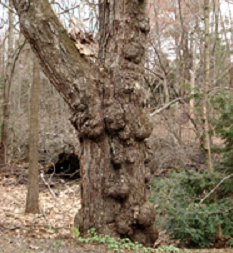Within this same plant tissue, individual living cells also have the ability to respond with inducible defenses. For example, when a leaf-eating insect has been detected, a plant will begin to produce toxic chemicals that if consumed will kill the insect. Production of pathogen-degrading enzymes are also a chemical defense that helps to destroy bacteria and/or fungi, stopping the pathogen from spreading. Some cells of the plant are deliberately shut down and die in an attempt to stop an invader.
Many plant species have cells equipped with what plant pathologists call Crazy Cells, or Idioblasts, which contain chemicals or sharp crystals that damage the mouthparts of insects and other herbivorous animals. Our native stinging nettle (Urtica dioica) produces stinging cells shaped like needles that break off when disturbed. Acorns of our mighty oak trees contain pigmented cells responsible for creating the bitter-tasting tannins that make this plant part undesirable as a food source for many animals.
 Additional examples of structural barriers include thorns and spines. The spines of the native prickly pear cactus (Opuntia sp.) are actually modified leaves or parts of leaves which clearly prevent uninhibited munching of the succulent, fleshy cactus pads. Most structural defense reactions by plants are visible to the human eye and alert us to pests in our garden spaces. The most common structural signs of a pest are leaf curling, holey or chewed-up leaves, and gall production.
Additional examples of structural barriers include thorns and spines. The spines of the native prickly pear cactus (Opuntia sp.) are actually modified leaves or parts of leaves which clearly prevent uninhibited munching of the succulent, fleshy cactus pads. Most structural defense reactions by plants are visible to the human eye and alert us to pests in our garden spaces. The most common structural signs of a pest are leaf curling, holey or chewed-up leaves, and gall production.
Plants certainly defend themselves in much different ways than animals. Plants have no red or white blood cells flowing through their sap. Nor do they have built-up antibodies ready to mount an attack from a specific pathogen or herbivore. Plants do, however, have many unique defenses, both chemical and structural, to detect and destroy invaders.
Photos:
Top, Right: Stinging Nettle (Urtica dioica) spines
Above, Left: Crown Gall on Euonymus sp.
Crown Gall on Euonymus sp.





